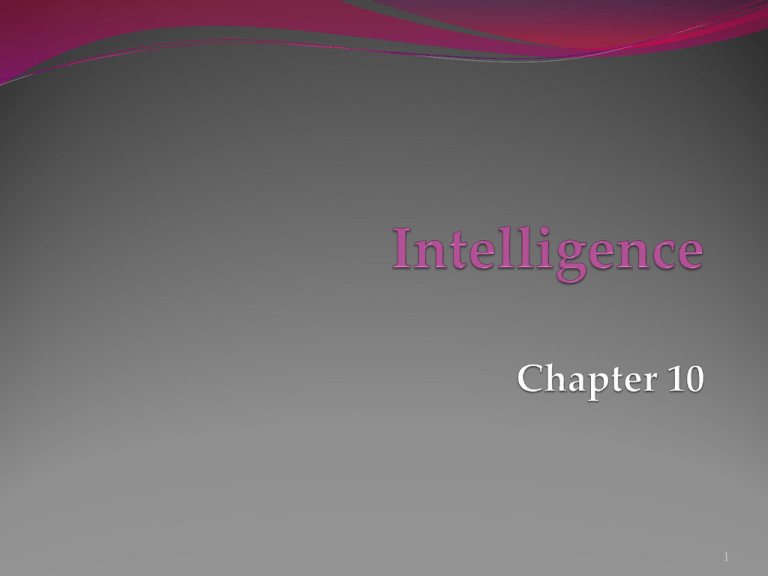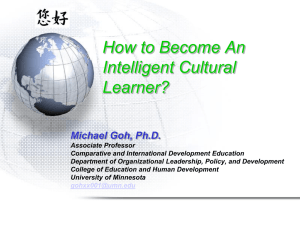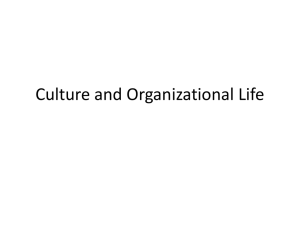Memory - Deerfield High School
advertisement

1 Intelligence What is Intelligence? Is Intelligence One General Ability or Several Specific Abilities? Emotional Intelligence Intelligence and Creativity Is Intelligence Neurologically Measurable? 2 Intelligence Assessing Intelligence The Origins of Intelligence Testing Modern Tests of Mental Abilities Principles of Test Construction The Dynamics of Intelligence Stability or Change? Extremes of Intelligence 3 Intelligence Genetic and Environmental Influences on Intelligence Genetic Influences Environmental Influences Group Differences in Intelligence Test Scores The Question of Bias 4 Intelligence Do we have an inborn general mental capacity (intelligence)? If so, can we quantify this capacity as a meaningful number? 5 What is Intelligence? Intelligence (in all cultures) is the ability to learn from experience, solve problems, and use our knowledge to adapt to new situations. In research studies, intelligence is whatever the intelligence test measures. This tends to be “school smarts.” 6 Conceptual Difficulties Psychologists believe that intelligence is a concept and not a thing. When we think of intelligence as a trait (thing) we make an error called reification — viewing an abstract immaterial concept as if it were a concrete thing. 7 Controversies About Intelligence Despite general agreement among psychologists about the nature of intelligence, two controversies remain: 1. Is intelligence a single overall ability or is it several specific abilities? 2. With modern neuroscience techniques, can we locate and measure intelligence within the brain? 8 Intelligence test A method for assessing an individual’s mental aptitudes and comparing them with those of others, using numerical scores 9 General Intelligence The idea that general intelligence (g) exists comes from the work of Charles Spearman (1863-1945) who helped develop the factor analysis approach in statistics. Athleticism, like intelligence, is many things 10 General Intelligence Spearman proposed that general intelligence (g) is linked to many clusters that can be analyzed by factor analysis. For example, people who do well on vocabulary examinations do well on paragraph comprehension examinations, a cluster that helps define verbal intelligence. Other factors include a spatial ability factor, or a reasoning ability factor. 11 General Intelligence L. L. Thurstone, a critic of Spearman, analyzed his subjects NOT on a single scale of general intelligence, but on seven clusters of primary mental abilities, including: 1. 2. 3. 4. 5. 6. 7. Word Fluency Verbal Comprehension Spatial Ability Perceptual Speed Numerical Ability Inductive Reasoning Memory 12 General Intelligence Later psychologists analyzed Thurstone’s data and found a weak relationship between these clusters, suggesting some evidence of a g factor. 13 Satoshi Kanazawa Satoshi Kanazawa (2004) argues that general intelligence evolved as a form of intelligence that helps people solve novel problems—how to stop a fire from spreading, how to find food during a drought, how to reunite with one’s band on the other side of a flooded river. More common problems—such as how to mate or how to read a stranger’s face or how to find your way back to camp—require a different sort of intelligence. Kanazawa asserts that general intelligence scores do correlate with the ability to solve various novel problems (like those found in academic and many vocational situations) but do not much correlate with individuals’ skills in evolutionarily familiar situations—such as marrying and parenting, forming close friendships, displaying social competence, and navigating without maps. 14 Contemporary Intelligence Theories Howard Gardner (1983, 1999) supports Thurstone’s idea that intelligence comes in multiple forms. Gardner notes that brain damage may diminish one type of ability but not others. People with savant syndrome excel in abilities unrelated to general intelligence. 15 Howard Gardner Gardner proposes eight types of intelligences and speculates about a ninth one — existential intelligence. Existential intelligence is the ability to think about the question of life, death and existence. 16 Robert Sternberg Sternberg (1985, 1999, 2003) also agrees with Gardner, but suggests three intelligences rather than eight. 1. 2. 3. Analytical Intelligence: Intelligence that is assessed by intelligence tests. Creative Intelligence: Intelligence that makes us adapt to novel situations, generating novel ideas. Practical Intelligence: Intelligence that is required for everyday tasks (e.g. street smarts). 17 Theories: Comparison 18 Social intelligence The know how involved in comprehending social situations and managing oneself successfully 19 Emotional Intelligence Emotional intelligence is the ability to perceive, understand, and use emotions (Salovey and colleagues, 2005). The test of emotional intelligence measures overall emotional intelligence and its four components. 20 Emotional Intelligence: Components Component Perceive emotion Understand emotion Manage emotion Use emotion Description Recognize emotions in faces, music and stories Predict emotions, how they change and blend Express emotions in different situations Utilize emotions to adapt or be creative 21 Emotional Intelligence: Criticism Gardner and others criticize the idea of emotional intelligence and question whether we stretch this idea of intelligence too far when we apply it to our emotions. 22 Neural plasticity Ability during childhood and adolescence to adapt and grow neural connections in response to their environment 23 Intelligence and Creativity Creativity is the ability to produce ideas that are both novel and valuable. It correlates somewhat with intelligence. 1. 2. 3. 4. 5. Expertise: A well-developed knowledge base. Imaginative Thinking: The ability to see things in novel ways. Adventuresome Personality: A personality that seeks new experiences rather than following the pack. Intrinsic Motivation: A motivation to be creative from within. A Creative Environment: A creative and supportive environment allows creativity to bloom. 24 Is Intelligence Neurologically Measurable? Recent Studies indicate some correlation (about +.40) between brain size and intelligence. As brain size decreases with age, scores on verbal intelligence tests also decrease. Gray matter concentration in people with high intelligence. 25 Brain Function Studies of brain functions show that people who score high on intelligence tests perceive stimuli faster, retrieve information from memory quicker, and show faster brain response times. People with higher intelligence respond correctly and quickly to the above question. 26 Assessing Intelligence Psychologists define intelligence testing as a method for assessing an individual’s mental aptitudes and comparing them with others using numerical scores. 27 Alfred Binet Alfred Binet and his colleague Théodore Simon practiced a more modern form of intelligence testing by developing questions that would predict children’s future progress in the Paris school system. 28 Lewis Terman In the US, Lewis Terman adapted Binet’s test for American school children and named the test the Stanford-Binet Test. The following is the formula of Intelligence Quotient (IQ), introduced by William Stern: 29 Aptitude and Achievement Tests Aptitude tests are intended to predict your ability to learn a new skill and achievement tests are intended to reflect what you have already learned. 30 David Wechsler Wechsler developed the Wechsler Adult Intelligence Scale (WAIS) and later the Wechsler Intelligence Scale for Children (WISC), an intelligence test for preschoolers. 31 WAIS WAIS measures overall intelligence and 11 other aspects related to intelligence that are designed to assess clinical and educational problems. Example WAIS 32 Principles of Test Construction For a psychological test to be acceptable it must fulfill the following three criteria: 1. Standardization 2. Reliability 3. Validity 33 Standardization Standardizing a test involves administering the test to a representative sample of future test takers in order to establish a basis for meaningful comparison. 34 Normal Curve Standardized tests establish a normal distribution of scores on a tested population in a bell-shaped pattern called the normal curve. 35 Flynn Effect In the past 60 years, intelligence scores have risen steadily by an average of 27 points. This phenomenon is known as the Flynn effect. 36 Reliability A test is reliable when it yields consistent results. To establish reliability researchers establish different procedures: 1. 2. 3. Split-half Reliability: Dividing the test into two equal halves and assessing how consistent the scores are. Reliability using different tests: Using different forms of the test to measure consistency between them. Test-Retest Reliability: Using the same test on two occasions to measure consistency. 37 Validity Reliability of a test does not ensure validity. Validity of a test refers to what the test is supposed to measure or predict. 1. 2. Content Validity: Refers to the extent a test measures a particular behavior or trait. Predictive Validity: Refers to the function of a test in predicting a particular behavior or trait. 38 The Dynamics of Intelligence Does intelligence remain stable over a lifetime or does it change? Are individuals on the two extremes of the intelligence scale really that different? 39 Stability or Change? Intelligence scores become stable after about seven years of age. In numerous studies, stability of intelligence scores have been determined (Angoff, 1988; Deary et al., 2004). 40 Extremes of Intelligence A valid intelligence test divides two groups of people into two extremes: the mentally retarded (IQ 70) and individuals with high intelligence (IQ 135). These two groups are significantly different. 41 Mental Retardation Mentally retarded individuals required constant supervision a few decades ago, but with a supportive family environment and special education they can now care for themselves. 42 High Intelligence Contrary to popular belief, people with high intelligence test scores tend to be healthy, well adjusted, and unusually successful academically. 43 Inequality in education Denying lower ability students opportunities for enriched education can widen the achievement gap between ability groups and increase their social isolation from one another By providing appropriate development placement suited for each child’s talents, we can promote equity and excellence for all 44 Genetic and Environmental Influences on Intelligence No other topic in psychology is so passionately followed as the one that asks the question, “Is intelligence due to genetics or environment?” 45 Genetic Influences Studies of twins, family members, and adopted children together support the idea that there is a significant genetic contribution to intelligence. 46 Adoption Studies Adopted children show a marginal correlation in verbal ability to their adopted parents. 47 Environmental Influences Studies of twins and adopted children also show the following: 1. 2. Fraternal twins raised together tend to show similarity in intelligence scores. Identical twins raised apart show slightly less similarity in their intelligence scores. 48 Early Intervention Effects Early neglect from caregivers leads children to develop a lack of personal control over the environment, and it impoverishes their intelligence. Romanian orphans with minimal human interaction are delayed in their development. 49 Schooling Effects Schooling is an experience that pays dividends, which is reflected in intelligence scores. Increased schooling correlates with higher intelligence scores. To increase readiness for schoolwork, projects like Head Start facilitate leaning. 50 Group Differences in Intelligence Test Scores Why do groups differ in intelligence? How can we make sense of these differences? 51 Ethnic Similarities and Differences To discuss this issue we begin with two disturbing but agreed upon facts: 1. 2. Racial groups differ in their average intelligence scores. High-scoring people (and groups) are more likely to attain high levels of education and income. 52 Racial (Group) Differences If we look at racial differences, white Americans score higher in average intelligence than black Americans (Avery and others, 1994). European New Zealanders score higher than native New Zealanders (Braden, 1994). White-Americans Black-Americans Average IQ = 100 Average IQ = 85 Hispanic Americans 53 Environmental Effects Differences in intelligence among these groups are largely environmental, as if one environment is more fertile in developing these abilities than another. 54 Reasons Why Environment Affects Intelligence 1. 2. 3. 4. 5. 6. Races are remarkably alike genetically. Race is a social category. Asian students outperform North American students on math achievement and aptitude tests. Today’s better prepared populations would outperform populations of the 1930s on intelligence tests. White and black infants tend to score equally well on tests predicting future intelligence. Different ethnic groups have experienced periods of remarkable achievement in different eras. 55 Gender Similarities and Differences There are seven ways in which males and females differ in various abilities. 1. Girls are better spellers 2. Girls are verbally fluent and have large vocabularies 3. Girls are better at locating objects 4. Girls are more sensitive to touch, taste, and color 5. Boys outnumber girls in counts of underachievement 6. Boys outperform girls at math problem solving, but under perform at math computation 7. Women detect emotions more easily than men do 56 The Question of Bias Aptitude tests are necessarily biased in the sense that they are sensitive to performance differences caused by cultural differences. However, aptitude tests are not biased in the sense that they accurately predict performance of one group over the other. 57 Stereotype Threat A stereotype threat is a self-confirming concern that one will be evaluated based on a negative stereotype. This phenomenon appears in some instances in intelligence testing among African-Americans and among women of all colors. 58







